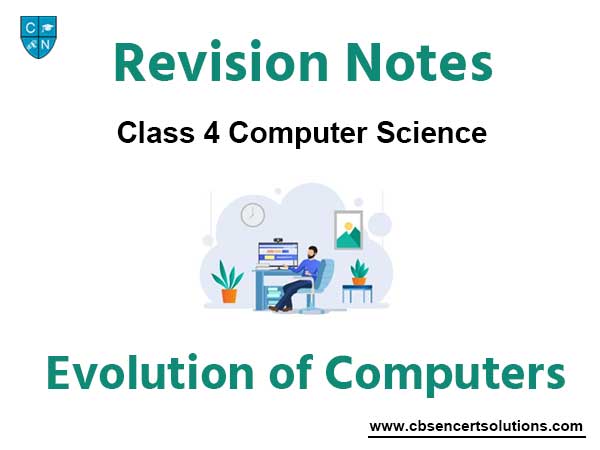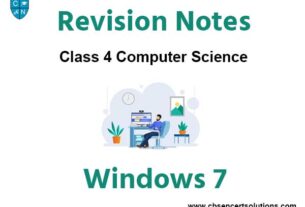Please refer to Evolution of Computers Class 4 Computer notes and questions with solutions below. These revision notes and important examination questions have been prepared based on the latest Computer books for Class 4. You can go through the questions and solutions below which will help you to get better marks in your examinations.
Class 4 Computer Evolution of Computers Notes and Questions
History of Computers
Earliest Computer: The first use of the word “computer” was recorded in 1613, referring to a person who carried out calculations, or computations, and the word continued to be used in that sense until the middle of the 20th century.
Tally Sticks
A tally stick was an ancient memory device used to record numbers, quantities or even messages.

Abacus
An abacus is a mechanical device used to aid an individual in performing mathematical calculations. It was invented in Babylonia in 2400 B.C. It was first used in China in around 500 B.C. It is used to perform basic arithmetic operations.

Napier ’ s Bones
It was invented by John Napier in 1614. It allowed the operator to multiply, divide and calculate square and cube roots by moving the rods around and placing them in specially constructed boards. A complete set of Napier bones consists of rod, one for each of the digit 0 to 9 called bones, with numbers carried on them.

Pascaline
In 1642, the young French philosopher and mathematician Blaise Pascal developed another mechanical adding machine called Pascaline, which could add and subtract numbers.

Later in the year 1671, Baron Gottfried Wilhelm Von Leibiniz of Germany developed a similar mechanical calculator that could also perform multiplication and division.
Jacquard Loom
The Jacquard loom is a mechanical loom, invented by Joseph-Marie Jacquard in 1881. It is an automatic loom controlled by punched cards.

Charles Babbage
Charles Babbage, an English mathematician and inventor, invented a Difference Engine made out of brass, pewter rods and gears in the 1830’s. It was an automatic, mechanical calculator designed to tabulate polynomial functions. In the year 1842, Babbage conceived the new idea of Analytical Engine that was intended to be completely automatic. It was capable of performing the basic arithmetic functions for any mathematical problem at an average speed of 60 additions per minute.

Hermen Hollerith
In the late 19th century, a young statistician, Hermen Hollerith invented punched card tabulating machine. It was designed to assist in summarizing information and accounting. That was the first time when data was stored successfully in an electronic device.

Mark-1
The first electro-mechanical computer, Mark-I was designed by a Harvard graduate student, Howard H. Aiken to solve advanced mathematical physics problems encountered in his research.
Generations of Computer
A computer generation can be divided into five generations.
First Generation Computers (1946 – 1956)
- The first generation computer systems used vacuum tubes for circuitry and magnetic drums for memory, and were often enormous, taking up entire rooms.
- Machine language (Binary numbers) was used as programming language.
- This computer was very complex to read and write programs by every person.
Examples of first generation computer are: ENIAC, EDVAC, EDSAC, UNIVAC-1, IBM 650, ABC, etc.
ENIAC
- The ENIAC (Electrical Numerical Integrator and Calculator) was the first electronic computer used for general purposes, such as solving numerical problems.
- It was invented in 1946 by John Presper Eckert and John W. Mauchl.
EDVAC
- EDVAC (Electronic Discrete Variable Automatic Computer) was one of the earliest electronic computers. Unlike its predecessor the ENIAC, it was binary rather than decimal, and was a stored-program computer.
- It has a memory to hold both a stored program as well as data.
EDSAC
- Electronic Delay Storage Automatic Calculator (EDSAC) is an early British computer and is considered to be the first stored program electronic computer.
- It was created at the University of Cambridge in England, performed its first calculation on May 6, 1949, and was the computer that ran the first graphical computer game, nicknamed “Baby.”
UNIVAC-1
- The UNIVAC I (Universal Automatic Computer 1) was the first commercial computer.
- The first UNIVAC-I was delivered on June 14, 1951. From 1951 to 1956, a total of 46 UNIVAC I computers were delivered, all of which have since been phased out.
IBM 650
- The IBM 650 Magnetic Drum Data-Processing Machine is one of the IBM’s earliest computers, and the world’s first mass-produced computer.
- It was announced in 1953 and in 1956 it was enhanced as the IBM 650 RAMAC with the addition of up to four disk storage units.
Second Generation Computers (1956-1965)
- Second generation computers used a new electronic device called transistor in the place of vacuum tube.
- Storage capacity of computers also increased during this generation.
- This generation computers were used for business applications.
- Programming language started in this generation known as FORTRAN (Formula Translation).
- Second-generation computers still relied on punched cards for input and printouts for output.
Examples of second generation computer are: IBM7094, IBM1620, IBM 1401, etc.
IBM7094
The IBM 7090 is a second-generation transistorized version of the earlier IBM 709 vacuum tube mainframe computers that was designed for “large-scale scientific and technological applications”.
IBM 1620
The IBM 1620 was announced by IBM on October 21, 1959, and marketed as an inexpensive “scientific computer”.
IBM 1401
The IBM 1401 is a variable word-length decimal computer that was announced by IBM on October 5, 1959.
Third Generation Computers (1965 – 1975)
- In third generation computers, transistors were replaced with Integrated Circuit (IC), which is a combination of number of transistors and other electronic components fused together on single crystal such as SSI, MSI.
- This generation machine uses magnetic tapes and magnetic disks as the secondary storage devices.
- These computers were much smaller and cheaper as compared to the second generation computers.
- High level languages like BASIC, COBOL, and FORTRAN, etc., were developed during this period.
Examples of third generation computer are: IBM360, Honeywell 6000 series computer, etc.
IBM360
- The IBM System/360 (S/360) is a family of mainframe computer systems that was announced by IBM on April 7, 1964.
- It was the first family of computers designed to cover the complete range of applications, from small to large, both commercial and scientific.
Fourth Generation Computers (1975 – present )
- In fourth generation computers, IC were replaced with Microprocessors.
- A microprocessor chip consists of thousands of integrated circuits and central processing unit in a single chip.
- Large Scale Integration (LSI) and Very Large Scale Integration (VLSI) Technology were used in fourth generation. The size of computer reduced & computing speed increased.
Examples of fourth generation computer are: Cray-1 Super computer, IBM PC, Apple Macintosh, etc.
Apple Macintosh
- The Macintosh is a family of personal computers designed, manufactured and sold by Apple Inc., since January 1984.
- The original Macintosh was the company’s first mass-market personal computer that featured a graphical user interface, built-in screen and a mouse
- The technologies used in Apple Macintosh are based on different Platforms
Fifth Generation Computer (Present – Beyond)
- In fifth generation computers, VLSI technology is replaced by Ultra Large Scale Integration (ULSI) and artificial intelligence technology.
- This technology helped to developed very small but extremely powerful and fast computers which come to be known as ROBOTS.
Examples of fifth generation are: PIM/m, Deep blue, etc.
Deep Blue
- Deep Blue was a chess-playing computer developed by IBM.
- The Deep Blue of IBM computer is that with artificial intelligence.
- It is known for being the first computer chess-playing system to win both a chess game and a chess match against a reigning world champion under regular time controls.



